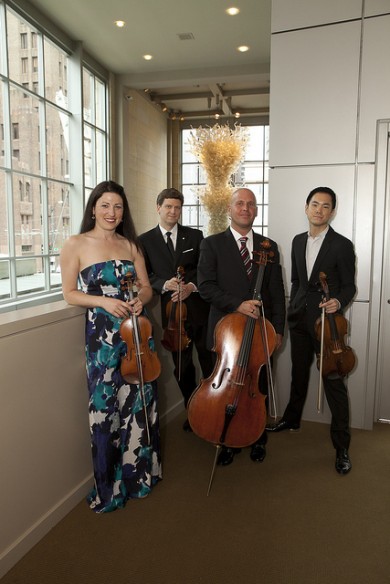Ehnes Quartet delivers vivid and moving performances

The Ehnes Quartet performed Sunday at St. Andrew’s Episcopal Church in Palmetto Bay.
The Ehnes Quartet’s performance on Sunday made clear this three-year-old ensemble has a big future, assuming all the members stick with it.
All have busy careers, however, and can’t devote full time to the venture. First violinist James Ehnes is a concert violinist with concerto and recital performances around the world. Second violinist Amy Schwartz Moretti, former concertmaster of the Oregon Symphony, is director of the Robert McDuffie Institute for Strings at Mercer University. Violist Richard O’Neill is a member of the Chamber Music Society of Lincoln Center and serves on the faculty of UCLA. Cellist Robert DeMaine has just won one of the plums of the classical world, becoming principal cellist of the Los Angeles Philharmonic.
But even if they can’t treat the quartet as their main job, chamber music’s roots lie in music-making as an avocation. And their performance at Saint Andrew’s Episcopal Church in Palmetto Bay, presented by Friends of Chamber Music of Miami, was as musically accomplished, concentrated and technically finished as that of the best-known quartets.
Their unity of attack was apparent from the forceful, aggressive manner with which they played the abrupt first notes of Samuel Barber’s String Quartet. And later in the movement, when the music seems to descend into chaos, with rapid tones that sound like the buzzing of bees, the first theme suddenly returns, and the quartet’s tight ensemble cohesion made that moment of sudden musical clarity that much more powerful.
The second movement is best known in its orchestral version as the Adagio for Strings, here played in its original form for string quartet. Rarely will you hear as moving and intense a performance, particularly for a work that may have lost much of its impact from excessive familiarity. In their hands, the quartet version achieved a keenness of expression that doesn’t come through in the plusher version for string orchestra. Ehnes brought a tone of yearning intensity to the long melody that dominates the movement, bowing in such a seamless manner that it sounded like he played the entire melody in one long stroke. Violist O’Neill’s tone was just right for this work, easily penetrating the surrounding strings, but with a gentleness suited to the music.
Shostakovich composed his String Quartet No. 8 in Dresden in 1960, 15 years after U.S. and British bombers destroyed the center of the city. He dedicated this dark work to the victims of fascism and war, and some listeners hear the sounds of explosions and the drone of bombers in the fortissimo chords that crash over a long-held tone in the first violin.
From the solemn, organ-like tones of the opening, the musicians entered sympathetically into the quartet’s world. Ehnes played a plaintive, tentative opening solo, restraining his tone and allowing more emphasis to fall on pedal points in the viola and cello, emphasizing the darkness of the passage. The Allegro molto followed with a violence and bite that showed the musicians unafraid to let some harshness break the ensemble’s normally glossy surface.
They lurched with the work from mood to mood – energetically playing a sudden waltz or folk melody, then brutally chopping away at the repeated chords over the long violin tone, the violins making sounds like the howling of a distant storm over a melody in the cello, then bringing a tone of compassion, resignation and comfort to a melody near the end.
After intermission, they lightened the mood with a delicate, humor-inflected performance of Hugo Wolf’s Italian Serenade.
The group ended the concert with another staple of the repertoire, the Ravel String Quartet. If the Barber and Shostakovich works offered vehicles for concentrated musical intensity, the Ravel gave the musicians the chance to show their sensual side. The wistful melodies of the first movement came off with a velvety texture over Ravel’s ingeniously scored accompaniments. The second and third movements were full of vivid tonal colors, and the finale was played with a fearless attack that provided an energetic ending to the concert.
Friends of Chamber Music’s next program presents pianist Rafal Blechacz May 7 at FIUs Wertheim Performing Arts Center. miamichambermusic.org; 305-372-2975
Posted in Performances
Leave a Comment
Mon Mar 4, 2013
at 10:21 am
No Comments




